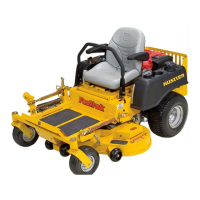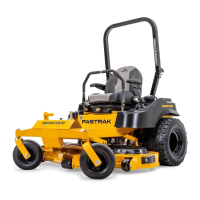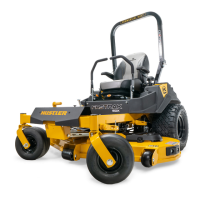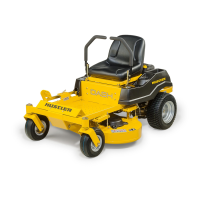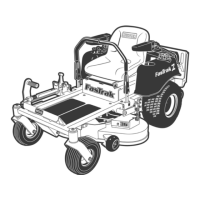601156_0110 3-5
2. Make sure the steering control levers are in the park
brake position and deck clutch switch is disengaged.
Only start the engine from the operator’s position.
3. Use choke, if unit is equipped with one, when engine is
cold, or if warm engine fails to start within 5 seconds of
cranking. Avoid flooding and operate engine without
choking as soon as possible.
4. Set throttle at approximately 1/2 open position.
5. Insert key in ignition switch and rotate full clockwise to
engage starting motor. Release key when engine starts.
IMPORTANT: The engine starter should not be oper-
ated for periods longer than 30 seconds at a time. An
interval of at least two minutes should be allowed
between such cranking periods to protect the starter from
overheating and burn-out.
6. Perform test to make sure safety start interlock system is
operating properly. Refer to Safety start interlock system
section.
7. As soon as engine begins to run, check to make certain
the oil warning light, engine light and alternator warning
light (if applicable) are off. If not, stop engine
immediately and check for the cause.
8. Allow the engine to idle a few minutes before advancing
the throttle and/or engaging the deck clutch.
9. Before stopping the engine, place the steering control
levers in the park brake position, disengage the deck
clutch, and throttle back to low idle for a couple of
minutes; then rotate ignition key counter-clockwise to the
OFF position. Remove the key from switch before
leaving the tractor.
Stopping the engine
Use the following procedure to shut off the engine after
operating the equipment.
1. Place the steering control levers in the park brake
position
2. Disengage the deck clutch
3. Throttle back to low idle for a couple of minutes
4. Rotate ignition key counter-clockwise to the OFF
position. Remove the key from switch before leaving the
tractor.
Moving tractor with stalled engine
If it becomes necessary to move the tractor when the engine is
inoperative, the transaxles are equipped with bypass valves.
FasTrak 36/42 (Mini FasTrak 36/42) - Before moving the
unit, pull out on the bypass valve rods and slide them into the
slot to lock in position. Both bypass valve rods are located
underneath the rear of the tractor at the back of the transaxle.
(Fig. 3-5)
FasTrak 48/54 - Before moving the unit, pull up on the
bypass valve rod and slide it in the slot to the disengaged
position. (Fig. 3-6)
The steering control levers must be placed in the neutral
position, to release the park brakes, so that the tractor can be
moved. Both bypass valve rods are located at the front corners
of the engine on the engine platform.
Do not tow the machine. Move it by hand or use a winch to
load on a trailer for transporting.
When transporting on another vehicle, the tractor must be
secured.
IMPORTANT: Always make certain the two bypass valves
are returned to their operating position before running the trac-
tor following repairs.
WARNING: Allow engine exhaust manifold to cool
before engaging or disengaging the bypass valves. The
bypass valve rods are located close to the exhaust sys-
tem.
Fig. 3-5
Fig. 3-6
Bypass valve rod shown in towing position
Bypass valve rod
(Left rod shown)
FasTrak 48/54
Mini FasTrak 36/42
Bypass valve rod
(Left rod shown)
(Viewed from the rear left underneath side)
Slot
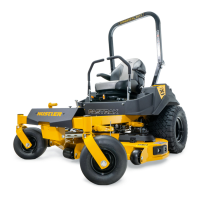
